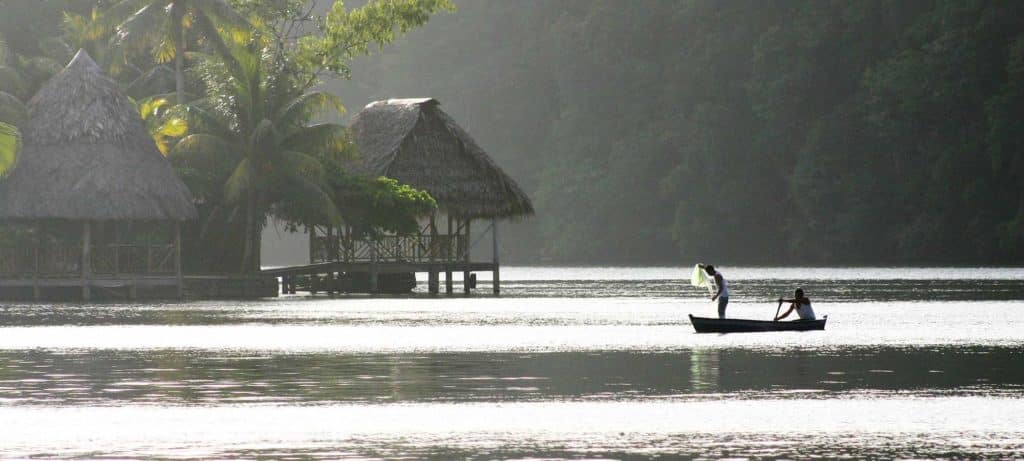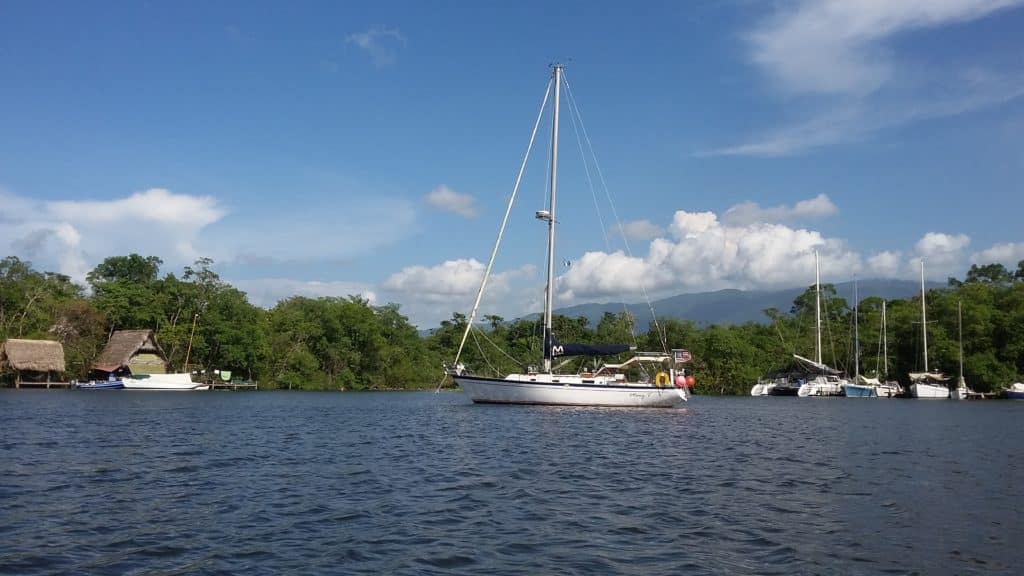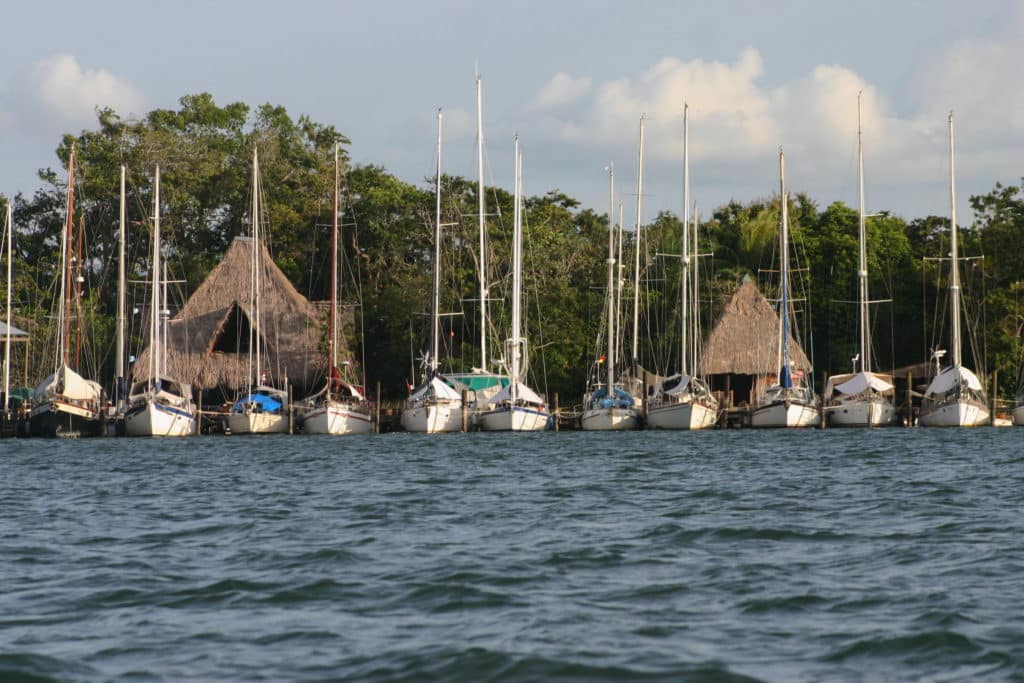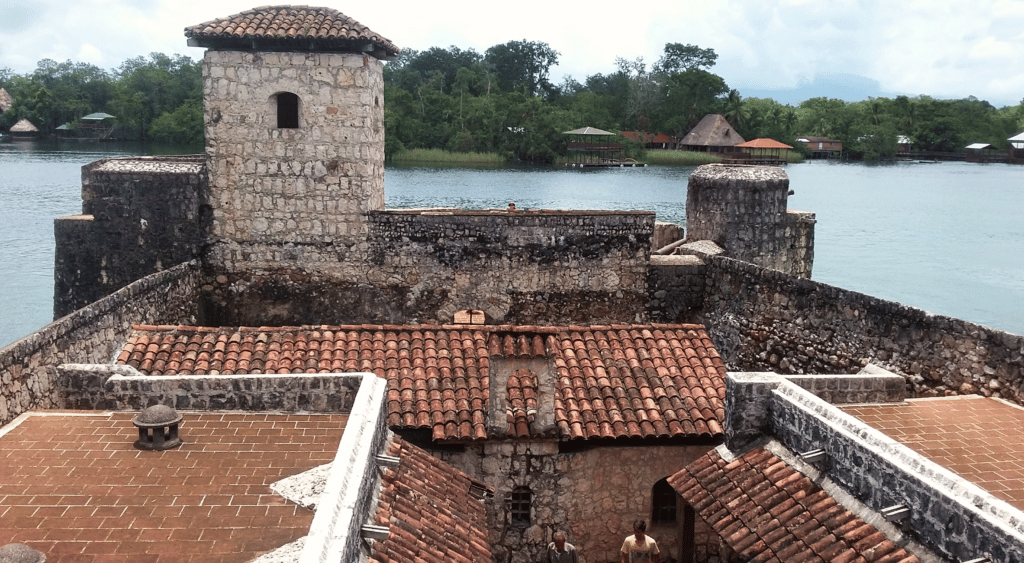
Slowly gliding up a creek in a launcha (a small, open powerboat), we spotted howler monkeys overhead in the branches of a breadnut tree. Usually, their haunting cries were frightening enough to scare the dead, but that day the howlers were quietly lounging on limbs, snacking on fruit. Farther up the creek, we encountered a father-and-son team skimming silently across the water in a cayuco, or canoe.
My husband, Ken, and I were visiting Guatemala’s Rio Dulce, or “sweet river.” It winds through cliffs and thick jungle for 20 miles, from its mouth in the Caribbean to the town of Fronteras, also known as Rio Dulce. It is a busy freshwater highway, and the focal point of life for those who live on its banks. The most common modes of transportation are cayucos and launchas. We saw locals washing clothes, bathing, and swimming in the river to cool off in the heat of the day, and young children paddling and fishing. Just beyond the town of Rio Dulce, the river opens up into the enchanting Lago de Izabal. Surrounded by verdant mountains, it is Guatemala’s largest lake.
When we made the decision to sail to Rio Dulce, I was most concerned about our safety; cruisers were killed there by robbers as recently as 2008. I also wondered about finding a marina where Mary T, our Morgan 38, would be looked after properly in our absence during the hurricane season. And then there was the bus ride from the marina to the airport in Guatemala City, because I’d heard horror stories of attacks on public transportation by armed bandits.
In my preoccupation with these concerns, I had failed to deeply consider the geography or the culture. I was blown away by what I found: a rich history; lush, majestic landscape; gentle people; tasty food; and everything ultimately affordable. And as it turned out, all my worries were for naught. The authorities have taken care of the highwaymen, and there are plenty of excellent marinas from which to choose.
Departing Livingston, on the Caribbean coast, and heading up the river feels like a trip back in time. Locals in cayucos tossed their hand-woven fishing nets in high arcs so they descended gracefully to the water to catch mojarra and robalo, which were offered at most restaurants. We followed the river as it wound through a jungle-cloaked canyon that was featured in a 1935 Tarzan movie. Eventually, the cliffs gave way to gentler slopes. Dwellings of all sizes, with elegantly crafted thatched roofs, dotted the river banks, blending gracefully into the lush backdrop. There were no mega hotels of glass and steel marring the landscape here.

Continuing upriver toward the town of Rio Dulce, the waters widened into an area called El Golfete. I was astounded by the vistas of mountain ranges to the north and south. On the south side of El Golfete, we anchored at Cayo Quemado, or Burnt Key. Many refer to it as Texan Bay because a cruiser named Mike, from Texas, used to run the marina and restaurant on the hill. Now Burnt Key Marina is operated by a Dutch merchant-marine captain named Maurits, while Mike manages the restaurant, Manglar, next door. Maurits told us he had traveled the world over by boat and decided to settle in Cayo Quemado because he’d finally found paradise. We explored the well-protected anchorage’s little creeks by kayak and dinghy. We frequently saw men and women of diminutive stature and advanced age carrying tremendous loads of corn or rice on their backs and heads. Locals living on the banks approached Mary T, selling handcrafted wares and coconut bread from their cayucos. They came with precious little children who looked up at us with dark, soulful eyes, making it nearly impossible not to buy something.
A short dinghy ride from Cayo Quemado, we visited a cave; augas calientes, or hot springs; and a natural sauna. At the restaurant on-site, we had delicious fresh fish and local fare. Felix, our cave guide, was a spritely man of 70 who skipped up the steep stone path to the cave like a man a third his age.
Twelve miles upriver from Cayo Quemado, we came to Puente Rio Dulce, the longest bridge in Central America, which crosses the river from the town of Rio Dulce to Relleno on the other bank. We had arrived at the heart of the region, where hundreds of cruisers enjoying the western Caribbean flock to store their vessels for hurricane season. It is 20 miles inland and rarely touched by those ocean storms. Everywhere we looked, there were masts.
Rio Dulce is a small, dusty, bustling town with stores and vendors’ stalls going right up to the edge of the road. Squeezing between cattle trucks and fruit stands in the heavy traffic required a certain amount of agility, but shopping was a pleasure because the produce was so affordable and fresh. Mangos, papayas, avocados and other local fruits cost less than half of what we were used to paying in the States. There were dozens of restaurants, and vendors grilling meat right on the street. We ate the traditional lunch, which included corn tortillas, beans, rice and meat for around 30 quetzales ($4 USD).

When we wanted to avoid the noise and heat of downtown, we bought food right on the river. Folks from Casa Guatemala, a local orphanage, came twice a week by launcha to the marinas and anchored their boats to hawk fresh produce, meats and cheeses. We could reach dozens of restaurants by dinghy. Most served fresh local fare with a western twist. Our favorites were the Sundog Cafe, for its excellent drinks and pizzas, and Bruno’s Marina. One cruiser cooked and sold lunch right from her boat for 25 quetzales a plate. We listened to the morning cruisers net for announcements of the daily lunch specials at a number of restaurants.
We found plenty of places to explore in and around Rio Dulce. One of these excursions was to the historic Castillo San Felipe, a well-preserved fort located at the bend in the river where the Rio Dulce meets Lago de Izabal. The 17th-century edifice was built by the Spanish to protect their territory from the British and pirates. We rode launchas to sites up and down the river that were too far to go by dinghy or kayak. Lago de Izabal was a fine place to see. We took Mary T, but we also could have seen it by launcha. There were a few restaurants and protected spots to anchor on its shores. We enjoyed investigating the many creeks off the river in search of howler monkeys, rare birds and restaurants. We discovered two eco-hotels hidden up creeks in the mangroves: Casa Perico and Kangaroo. Both were great stops for lunch and beverages.
One day, Ken and I ventured out of town on a collectivo bus to Finca El Paraiso, where we swam under a near scalding-hot waterfall that emptied into a cool pool. When it started getting busy there, we hopped on another collectivo to El Boqueron, where an old man took us for a ride in his cayuco up an enchanting river canyon. The return collectivo trip to Rio Dulce involved some acts of contortion as we were obliged to stand hunched over the other passengers until seats became available.

More comfortable, air-conditioned buses were available for travel farther afield. Antigua Guatemala, the beautifully preserved former capital of the Kingdom of Guatemala and a UNESCO World Heritage site, was definitely worth the visit. Volcanoes provided the backdrop to brightly painted colonial buildings and grand cathedrals in various stages of decay. The town of Panajachel on Lake Atitlan was another must-see. This breathtaking crater lake is surrounded by mountains and three volcanoes. In both places, vendors plied the streets with brightly colored hand-woven fabrics and trinkets.
Boat maintenance in Rio Dulce cost a fraction of what we’ve paid in the United States. There were a number of skilled locals and expats who did every kind of boat work imaginable. We had a new mainsail sewn by an Italian expat named Luigi, and folks at Captain John’s varnished our Morgan 38 inside and out, and had it looking better than ever upon our return from the States.
We found Rio Dulce’s cruising community to be very active and generous. I was most impressed by the volunteer work being undertaken in remote villages, including a volunteer organization called Pass It On Guatemala that brings solar panels and boat batteries to provide light to clinics and school. The smiles on the faces of the villagers when the lights go on is the payoff for volunteers.
The cruisers in Rio Dulce set an inspiring example. We sailors can only go so long treating ourselves with new vistas, adventures and local cuisine, right? At some point we need to do something for someone else. Pass it on.
Amy Flannery is a filmmaker and lives aboard the Morgan 38 Mary T with her husband, Ken Kurlychek.








